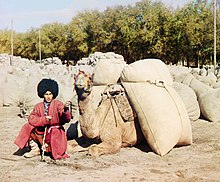
The history of Turkmenistan traditionally began with the arrival of Indo-European Iranian tribes around 2000 BC. Early tribes were nomadic or semi-nomadic due to the arid conditions of the region, preventing widespread adoption of agriculture. The steppe culture in Central Asia was an extension of a larger Eurasian series of horse cultures which spanned the entire spectrum of language families, including the Indo-Europeans and Turko-Mongol groups. Some of the known early Iranian tribes included the Massagatae, the Scythians/Sakas, and early Soghdians, who were most likely precursors of the Khwarezmians. Turkmenistan was a passing point for numerous migrations and invasions by tribes, which gravitated towards the settled regions of the south, including ancient Mesopotamia, Elam, and the Indus Valley civilization.

The flag of Turkmenistan features a white crescent and five stars representing the five regions of the country and the Five Pillars of Islam. Placed upon a green field is a symbolic representation of the country's famous carpet industry. It was introduced as the flag of Turkmenistan on 27 September 1992 to replace the Soviet-era flag which consisted of a red background with two light blue bars in the middle. The modified version with a 2:3 ratio was adopted on 23 January 2001. State Flag and Constitution Day is celebrated on 18 May.

Mary Region is one of five provinces in Turkmenistan. It is located in the south-east of the country, bordering Afghanistan. Its capital is the city of Mary. Its area is 87,150 km2 (33,650 sq mi) and population 1,613,386. The average population density is about 15 persons per square kilometer, but it reaches 150–200 per square kilometer in the most developed oases.

Turkmens are a Turkic ethnic group native to Central Asia, living mainly in Turkmenistan, northern and northeastern regions of Iran and north-western Afghanistan. Sizeable groups of Turkmens are found also in Uzbekistan, Kazakhstan, and the North Caucasus. They speak the Turkmen language, which is classified as a part of the Eastern Oghuz branch of the Turkic languages.
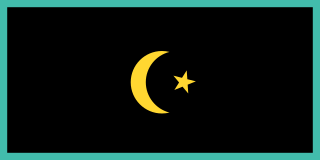
The Khanate of Khiva was a Central Asian polity that existed in the historical region of Khwarezm in Central Asia from 1511 to 1920, except for a period of Afsharid occupation by Nader Shah between 1740 and 1746. Centred in the irrigated plains of the lower Amu Darya, south of the Aral Sea, with the capital in the city of Khiva. It covered present-day western Uzbekistan, southwestern Kazakhstan and much of Turkmenistan before the Russian arrival at the second half of the 19th century.

The Kayı or Kayi tribe were an Oghuz Turkic people and a sub-branch of the Bozok tribal federation. In his Dīwān Lughāt al-Turk, the 11th century Kara-Khanid scholar Mahmud al-Kashgari cited Kayı as of one of 22 Oghuz tribes, saying that Oghuz were also called Turkomans. The name Kayı means "the one who has might and power by relationship" and the Turkmen proverb says that "people shall be led by Kayi and Bayat tribes".
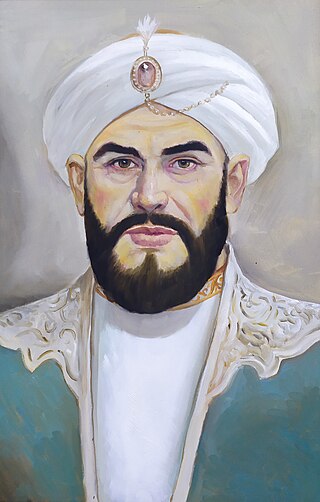
Abu al-Ghazi Bahadur was Khan of Khiva from 1643 to 1663. He spent ten years in Persia before becoming khan, and was very well educated, writing two historical works in the Khiva dialect of the Chagatai language. He was a descendant of Genghis Khan via Arab Shah.

Salur, Salyr or Salgur was an ancient Oghuz Turkic tribe and a sub-branch of the Üçok tribal federation.

The Chowdur or Choudor are one of the ten major groups of people who merged after 1920 to form the modern Turkmen Republic. They live primarily in and around the Khorezm Oasis.

A Turkmen rug is a type of handmade floor-covering textile traditionally originating in Central Asia. It is useful to distinguish between the original Turkmen tribal rugs and the rugs produced in large numbers for export mainly in Pakistan and Iran today. The original Turkmen rugs were produced by the Turkmen tribes who are the main ethnic group in Turkmenistan and are also found in Afghanistan and Iran. They are used for various purposes, including tent rugs, door hangings and bags of various sizes.

Ersari are one of the major tribes of the Turkmen people of Central Asia and one of the five major tribes of the country of Turkmenistan. They live mainly in Turkmenistan, Afghanistan and Pakistan.

The list of Turkmenistan-related articles is below

The Yomut or Yomud is a Turkmen tribe that lives in Western and Central Asia, including Gorgan, Iran; Turkmenbashi, Turkmenistan; the eastern Caspian shores; Khiva, Uzbekistan; and Dashoguz, Turkmenistan.

Iranian Turkmens are a branch of Turkmen people living mainly in northern and northeastern regions of Iran. Their region is called Turkmen Sahra and includes substantial parts of Golestan Province of Iran. The number of Turkmens in Iran is estimated at 0.5 to 2.4 million people.

Bayat is one of the Oghuz tribes in Turkmenistan, Iran, Turkey, Azerbaijan, Iraq, Afghanistan, and Syria. When Oghuz Turks started to migrate from the Aral steppes to Khorasan in the 11th and 13th centuries, Bayat people spread throughout the region. They are sub-ethnic groups of Turkmens and Azerbaijanis. The Bayats are Muslim and speak a southern dialect of Azerbaijani language in Azerbaijan and Iran, or their own dialect of Turkish in Turkey, and Ersari dialect of Turkmen in Turkmenistan and Uzbekistan. The ancient Turkmen proverb says: "Kayi and Bayat tribes shall lead the people".
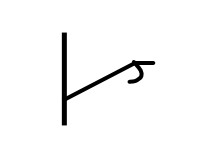
Qiniq also spelled Qïnïq, Qynyk or Qynyq, was an Oghuz Turkic tribe.

Junaid Khan ; (b.1857/62–1938) was a Turkmen tribal leader who became the Chief of the Armed Forces and later the de facto and last ruler of the Khanate of Khiva.
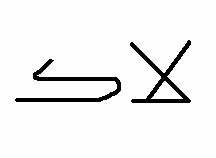
Begdili were an Oghuz Turkic people and a sub-branch of the Bozok tribal federation. Currently, the descendants of Begdili tribe and those who identify themselves as such are part of the Geklen Turkmens living in the Balkan velayat of Turkmenistan. They also can be found among Ersari Turkmens, who live predominantly in the Lebap velayat (region) of Turkmenistan and northern provinces of Afghanistan. Turkish Begdili Turkomans live in Tarsus, Aleppo, and in many parts of Anatolia. Cerit/Ceritli Turkomans are a branch of Begdili tribe.

Shajara-i Tarākima is a Chagatai-language historical work completed in 1659 by Khan of Khiva and historian Abu al-Ghazi Bahadur.

Ersari baba is the legendary leader of the Ersari tribe, who, or most probably whose historical prototype, lived in 13th or 14th century in Mangyshlak or in the vicinity of Balkan mountains. He was the founder of the loose Sayin Khan Turkmen confederation and is considered to be a common ancestor of all Ersari people, who today live predominantly on the banks of the Amudarya River in Lebap velayat of Turkmenistan and northern provinces of Afghanistan. "Ersari" literally means "yellow brave man" from Turkic (Turkmen) "er" or "är" - brave man, and "sari" or "sary" - yellow.





